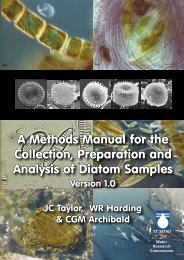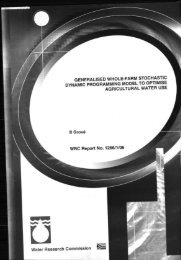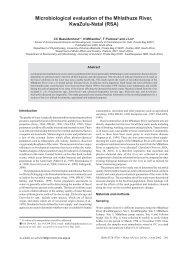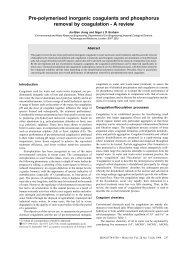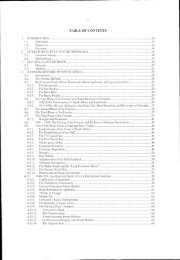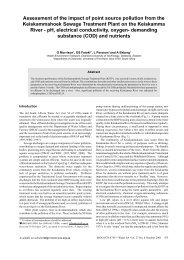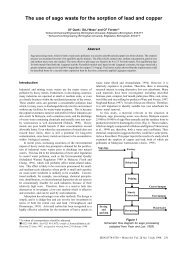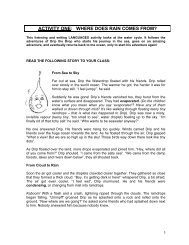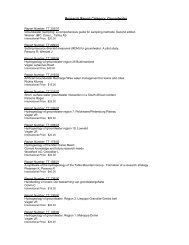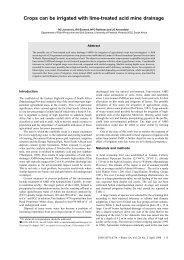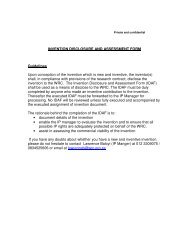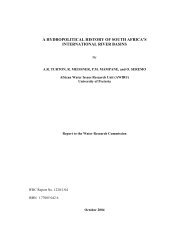and the Efficacy of Pit Latrine Additives - Water Research Commission
and the Efficacy of Pit Latrine Additives - Water Research Commission
and the Efficacy of Pit Latrine Additives - Water Research Commission
- No tags were found...
You also want an ePaper? Increase the reach of your titles
YUMPU automatically turns print PDFs into web optimized ePapers that Google loves.
2 REVIEW OF EXISTING KNOWLEDGE ON THE PROCESSES IN PIT<br />
LATRINES<br />
The term “pit latrine” describes virtually any system that accumulates faecal matter, urine <strong>and</strong> possibly o<strong>the</strong>r<br />
material over a period <strong>of</strong> more than a few days. The design <strong>of</strong> <strong>the</strong>se systems varies considerably from place<br />
to place due to user habits, cultural preferences, available building materials <strong>and</strong> terrain. A comprehensive<br />
literature review <strong>of</strong> issues relating to design, operation, maintenance, health, social <strong>and</strong> management<br />
aspects <strong>of</strong> pit latrines is presented in Cotton et al. (1995).<br />
In general, pits are allowed to fill to within a certain proximity to <strong>the</strong> top <strong>of</strong> <strong>the</strong> pit (e.g. 300 mm) <strong>and</strong> <strong>the</strong>n<br />
ei<strong>the</strong>r emptied by pumping out <strong>the</strong> contents (or in <strong>the</strong> case <strong>of</strong> solid contents, digging out) or buried over. In<br />
<strong>the</strong> latter case, a new pit is dug nearby, <strong>and</strong> <strong>the</strong> superstructure moved or rebuilt. A period <strong>of</strong> stabilisation<br />
may be allowed before pit contents are removed, although this is not <strong>of</strong>ten <strong>the</strong> case since alternative<br />
sanitation facilities are not usually available where pit latrines are to be dug/pumped out <strong>and</strong> reused<br />
(Franceys et al., 1992).<br />
2.1 Biological processes in pit latrines<br />
The mechanism <strong>of</strong> treatment in a pit latrine has not been given much consideration in <strong>the</strong> literature. In<br />
general, pit latrines are regarded as accumulation systems, <strong>and</strong> <strong>the</strong> fate <strong>of</strong> <strong>the</strong> contents <strong>the</strong>re<strong>of</strong> is ignored<br />
until <strong>the</strong> pit fills <strong>and</strong> requires emptying. The few authors who have considered <strong>the</strong> processes in <strong>the</strong> pit agree<br />
that below <strong>the</strong> surface <strong>of</strong> <strong>the</strong> pit contents, <strong>the</strong> predominant mechanism <strong>of</strong> digestion, if indeed any occurs at<br />
all is anaerobic digestion (Mara, 1984; Still, 2002; Chaggu, 2004) although aerobic degradation processes<br />
may occur at <strong>the</strong> air interface (top surface).<br />
Mara (1984) describes <strong>the</strong> mechanism <strong>of</strong> treatment in terms <strong>of</strong> two effects:<br />
<br />
<br />
Liquid components <strong>of</strong> <strong>the</strong> pit infiltrate <strong>the</strong> surrounding soil. This may cause (structural) instability in <strong>the</strong><br />
ground in which <strong>the</strong> pit is located. Groundwater contamination may result. (Mara, 1984; Franceys et al.,<br />
1992)<br />
Anaerobic digestion converts solids originating from faeces to (i) gases: carbon dioxide (CO 2 ), methane<br />
(CH 4 ) <strong>and</strong> hydrogen sulphide, (H 2 S) that leave via <strong>the</strong> vent pipe; <strong>and</strong> (ii) to soluble products that drain<br />
away with <strong>the</strong> liquid content <strong>of</strong> <strong>the</strong> pits. (Mara, 1984; Franceys et al., 1992).<br />
Franceys et al. (1992) fur<strong>the</strong>r state that residence in <strong>the</strong> pit has a sanitising effect on pathogens, since <strong>the</strong>y<br />
are not able to survive during <strong>the</strong> decomposition processes due to changes in temperature (high<br />
temperatures during composting are mentioned) <strong>and</strong> moisture.<br />
Franceys et al. (1992) indicate that any available oxygen will result in aerobic conversion processes<br />
occurring.<br />
The extent <strong>of</strong> conversion <strong>of</strong> biodegradable organic material to biomass <strong>and</strong> gases is called <strong>the</strong> extent <strong>of</strong><br />
stabilization; a fully stabilised material has no biodegradable component remaining.<br />
The micro-organisms that degrade organic material in <strong>the</strong> pit latrine (ei<strong>the</strong>r aerobically or anaerobically)<br />
originate from faecal material, soil, leaves, or from faecal sludge added to or left in a pit that has been<br />
emptied. The rate <strong>of</strong> treatment is dependent on (among o<strong>the</strong>r factors) <strong>the</strong> number <strong>of</strong> degradative microorganisms<br />
in <strong>the</strong> pit. A number <strong>of</strong> authors have suggested that <strong>the</strong> rate <strong>of</strong> stabilisation <strong>of</strong> pit contents,<br />
5



